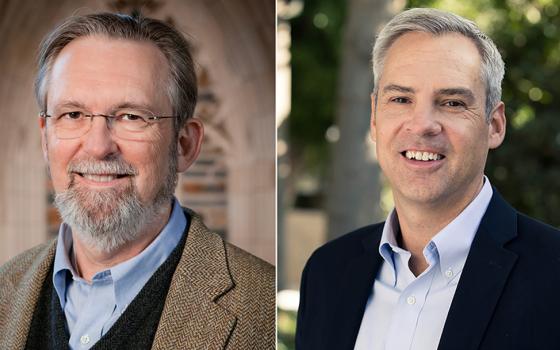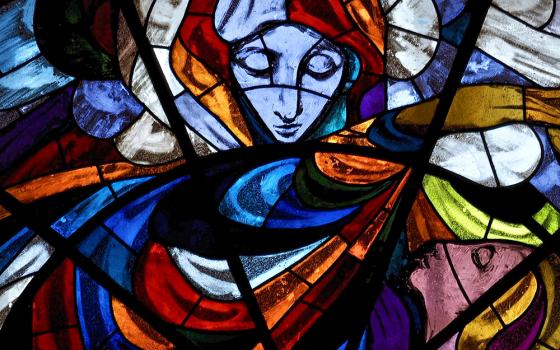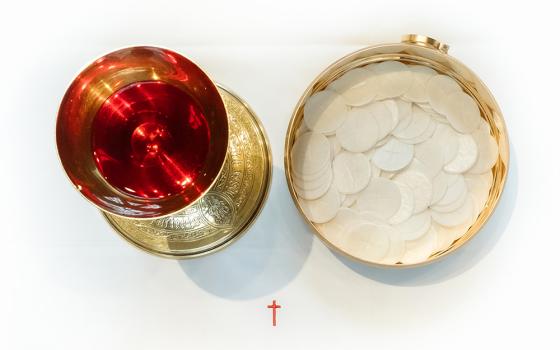Every now and then, we see someone whose face, maybe even his or her whole being, appears radiant. People speak of brides and grooms as glowing with joy. That kind of glow has nothing in common with gloating and is far more than a smile of pleasure or appreciation. It is even more than joy. It might appear when parents first behold their child, or see that child accomplish something wonderful. We seem to glow in moments of genuine fulfillment and love. When we understand what has caused that sort of feeling to shine forth from others, we get a glimpse of their deepest desires and the essence of who they are. That is what the disciples saw happen to Jesus as he prayed on the mountain.
Usually, we need to know a person well to recognize that look on their face. Models and actors try to imitate it as they promote a product that is supposed to create the feeling, but they usually just come off as people who should be advertising toothpaste. You can’t fake genuine joy and integrity.
When Jesus invited Peter, James and John to go up to pray with him, he must have been hoping that they would understand him when they shared his prayer. He had tried to explain himself to them by revealing what he knew of his destiny, but they couldn’t grasp it, so he invited them into his experience of prayer. Who knows if he anticipated the experience that he and they had while there?
As the disciples nodded and dozed, Jesus entered into communion with his Father. We would call this sort of prayer mystical. The Gospel writers say nothing about Jesus’ words; they simply indicate that his prayer was an experience of loving union with his Father that involved his entire being. It was as if every bit of his person, his history, his openness to the future, his loves, and his frustrations were laid bare. He offered himself to and was wholly received by his Father. That experience so filled him that his face took on the look of grace and his entire being glowed.
In seeing this, the three disciples caught a glimpse of the depth and breadth of Jesus’ identity. That vision enlightened them about his relation to their entire religious tradition and his relationship with God. Moses and Elijah represented the Jewish tradition, the Law and the prophets, all oriented toward the day of the coming savior, God’s chosen one.
Although we are not privy to their words, Luke tells us that Moses and Elijah spoke with Jesus about his upcoming exodus — the suffering and death he knew he was facing and God’s promised, unimaginable third day. The disciples probably understood this no more than they had understood his prediction about his coming passion.
Then came the climax. Before Peter could carry out any sort of plan, the three disciples heard the heavenly voice tell them all they ever needed to know: “This is my chosen Son; listen to him.”
As we heard in today’s first reading, God had led Abram to marvel at the stars of night in order to engender his trust. When Jesus invited his disciples to be with him in prayer, he allowed them to see the most intimate and deepest dimension of his being. That led to the greatest revelation they had ever received. They never explained how they heard God’s voice, but they got the message: “Listen to him!” And as if to underline that message, when the voice had finished, they saw only Jesus — he who was all they needed.
Of course, they couldn’t fulfill God’s command all at once. They had to live into it as they had already been doing. They had to follow the road through all the way to the Resurrection and Emmaus. They had to wait for the Spirit to descend on them before their own faces would shine like his. But they heard enough to trust Jesus when logic and their own hopes urged them to quit.
Although we can’t go up that same mountain nor enjoy encounters with God as did Abraham, the Gospels were written to allow us to contemplate Jesus and, like the disciples, to learn how he is God for us in every sense of the phrase. We have the advantage of the disciples’ insights, but we still must discover for ourselves what it means to listen to him in our own time. That means we too must come to know Jesus well and, like the disciples, we must allow ourselves to be overshadowed by God’s presence. Through that sort of listening, we will be lured into adopting Jesus own logic, hopes and prayer. Then, on occasion, our faces too will glow.
GENESIS 15:5-12, 17-18
Each year on the Second Sunday of Lent, we have an encounter with Abram. In Year A, we hear God call him; in Year B, we remember his testing. This year, we watch as God makes and seals the covenant with him. The scene opens as Abram is presumably sitting comfortably at home, conversing with God. When God tells Abraham that his posterity will be great, Abram humbly mentions the fact that he is old and childless. Abram was respectful, but realistic.
With that, God took Abram outside to gaze on the mind-boggling profusion of stars that appear on a dark, clear night in the desert. Saying, “Count them if you can!” God invited Abram to go beyond the constrictions of the familiar way of life symbolized by the house he owned and his peaceful, predictable way of life. God was inviting him into the unimaginable adventure of faith, an adventure that would include him and his descendants who would be as numberless as the stars.
Perhaps beholding those stars impelled Abraham to place his faith in the Lord. After all, the God who could create those stars could surely give him progeny. All we know is that “Abram put his faith in the Lord.”
Abram took the definitive step from believing in what he knew, to trusting in what God promised. This fundamental act of faith shifted Abram’s outlook from believing in himself, his experience and the known world, into believing that God alone was God and worthy of trust. Abram began to believe in God more than he believed in himself. This is what the Lord credited to Abram as righteousness.
In the book Preaching the New Lectionary, Year C, Congregation of St. Agnes Sr. Dianne Bergant notes that “righteousness” is a word that describes quality of relationship. A person is righteous only in relationship to another, which implies that what is called self-righteousness is a shallow sham. God’s acceptance of Abram’s faith set Abram in proper relationship with God.
We should note that Abram’s faith didn’t preclude questioning God. He had to ask, “How am I to know? As he was making the shift from trusting his own wisdom and experience to relying totally on God, he needed to be led. God’s promise was beyond his realm, thus his question itself was an act of faith.
God responded with an extraordinary covenant ceremony. God had Abram gather all the traditional sacrificial animals and split them in two. Although Abram neither burned nor ate them as in traditional sacrifices, he protected the offerings from the preying birds that represented dangers to the covenant.
Then, God put Abram into a trance, a deep and terrifying darkness. God’s passing between the halves of slaughtered victims was the strongest covenant expression possible; it symbolized that the fate of the animals would fall to anyone who broke the agreement. In this case, only God passed through, meaning that God’s commitment was total; breaking this covenant would mean that God would cease to be God. Thus, it was impossible that his covenant would not last. After that, God completed the pact, promising a land to Abram’s numerous descendants.
This incident in Abram’s life tells us what faith entails. Although it may sound simplistically obvious, Abram shows us that faith implies that we recognize we are not God, and that only God is God. Abram expressed this faith by emigrating from his home, leaving behind everything he thought he knew to be true for God’s sake. Doing that readied him for a proper (righteous) relationship with the God who would do unfathomable things for him and who would always remain true.
PSALM 27:1, 7-8, 8-9, 13-14
With both the refrain and the verses, Psalm 27 reinforces those who pray it in the conviction that only God is God. We can place our trust in God as our guide and our refuge. The psalmist makes this a very personal prayer by the continued use of the first person. We proclaim faith in God, seek God’s mercy, and finally proclaim our hope to know God’s bounty in the land of the living.
Praying this psalm prepares us for the Gospel as we beg, “Hide not your face from me.” With that phrase, we summarize all the petitions of the psalm. We are asking to be aware that we are always in God’s presence.
PHILIPPIANS 3:17-4:1
This selection from Paul’s letter to the Philippians offers both a commentary on and themes for meditation on the Gospel story of the Transfiguration. As in so many other counsels from Paul, this is directed to a community and makes sense only when interpreted from the framework of community.
The core of Paul’s message is the assertion that “our citizenship is in heaven.” Saying that, he is drawing on the Philippian’s proud experience of being a Roman colony. In this reading, Paul contrasts the citizens of heaven with enemies of the cross of Christ whose living actually brings him to tears.
Paul’s contrasts are as applicable today as in his own. The enemies of the cross are those who are headed for and complicit in destruction. Their god is their belly — all that is physically attractive from food, to displays of beauty, to sexual pleasures. When pleasures become their god, their pursuit of gratification is subject to no other law or morality other than their own satisfaction. The statement that “their glory is their shame” declares the ultimate decadence and futility of all their pursuits.
In contrast, Paul describes the Christian community as something like an immigrant colony of people who have their real politeuma or citizenship in heaven. In Paul’s day, politeuma referred to a group of foreigners who had permission to live in a land not their own and maintain their own order in terms of leadership, culture, etc. That would be the Corinthians’ challenge.
The situation of the Jews in Israel in those days offers a particularly apt comparison to Paul’s idea of Christian citizenship. Under Roman rule, they maintained their distinct identity through practicing their faith with its moral law and cultural norms. They expressed their distinction from others through such things as their dress, their worship, restrictions about who their young could marry, with whom they could eat, and who could enter the Temple. Although Paul did not attribute saving power to the Jewish adherence to the law, he could draw on their experience to elucidate what he was saying about the Christian community.
Unlike the Jews, Paul’s Christians were not expected to dress differently, eat in exclusive groups, etc. Rather, the distinction between Christians and those who dedicate themselves to their own gratification has to do with their orientation toward the future and how it impinges on the present. Christians are focused not on themselves or material values but on the future they await and in which they already participate by living its values in the present.
In the opening line of this passage, Paul told the Philippians to imitate him. At the end, he explains why: Imitating him is the way to anticipate the Savior who will conform us to his own way of being. Pope Francis brings this concept to the 21st century by rejoicing in the new possibilities technology offers for building an alternative to a world seeking only its own gratification. Francis suggests that our networks of communication offer new possibilities “of finding and sharing a ‘mystique’ of living together, of … encounter, of embracing and supporting one another … which … can become a genuine experience of fraternity, a caravan of solidarity.” (Gaudium Evangelii, #87). Thus, paraphrasing Paul and Francis, this reading invites us to be cyber-citizens who live in our world, promoting the values of the heaven we anticipate.
LUKE 9:28b-36
The Gospel for the Second Sunday of Lent is always an account of Jesus’ transfiguration. Each year, it is heard according to the evangelist whose Gospel is featured in that cycle. Today, we hear Luke’s version of the event. Luke places the event about eight days after Jesus gave the disciples the first of three explanations of his upcoming passion, death and resurrection. Jesus’ prediction of the humiliation, suffering and death that would usher in his glory was more than they could take in. So too, his appearance on the mountain was largely beyond the immediate comprehension grasp of his closest disciples.
The event of Jesus’ transfiguration is full of theological symbols that situate him in relation to his tradition, his unique vocation, and his relationship with his Father. It takes place on a mountain, reminiscent of experiences that Elijah and Moses had of meetings with God. Luke’s note that this took place about eight days after the discussion of Jesus’ upcoming passion subtly reminds us of the eighth day on which the Emmaus disciples began to understand Jesus’ cross and resurrection.
The essential action of the story is that Jesus was praying. In that moment, communion with his Father caused his very appearance to change. It was as if the reality of who he was in relationship to the Father became tangible. His inner self became visible through his radiant face, even to the extent that his whole being shone as symbolized by his dazzling white clothing. Nothing but the resurrection could compare to Jesus physical appearance in this moment; we might say that in both cases, the overwhelming truth of who he was became evident to those who encountered him.
Moses and Elijah who appeared with Jesus also revealed a dimension of who he was. By conversing with them about his “exodus,” Jesus was situating himself clearly within Judaism. Moses and Elijah, two of the holiest men of the tradition, represent the Law and the prophets. The fact that they spoke about his exodus signified that what Jesus was about to do would be the culmination of God’s plan and action in history.
All of this can be understood from two vantage points. On one hand, it was obviously a revelation for the disciples who saw it; it told them who Jesus was. At the same time, the conversation, combined with the voice that came from heaven, expressed Jesus’ complete union with his Father. If we believe that Jesus prayed to understand the Father’s will, we can understand his transfiguration as revelation and an affirmation of his role in salvation history.
For the three disciples, the experience was overwhelming and revelatory. The Jesus whom they had followed along the way, the one who taught them and then predicted his passion, now appeared before them in the glory of his intimacy with God. And in case they didn’t comprehend what they saw, the voice of God revealed all that they would ever need to know: “This is my chosen Son, listen to him.”
Planning: Second Sunday of Lent
By Lawrence Mick
You may recall that the first readings during Lent last year often focused on the covenants God made with humanity. This year, that is not so evident, but this Sunday brings us a covenant ritual in the first reading. God makes several promises to Abram (his name was later changed to Abraham). The splitting of the animals is explained in the New American Bible this way: “Cutting up animals was a well-attested way of making a treaty in antiquity.” (See footnotes for Genesis 15:9-17) Jeremiah 34:17-20 indicates that this rite is a form of self-imprecation in which violators invoke the fate of the animals upon themselves. The eighth-century B.C.E. Sefire treaty from Syria reads, “As this calf is cut up, thus Matti’el shall be cut up” (Ibid.). The smoking fire pot and the flaming torch (v. 17), which represent God, pass between the pieces, making God a signatory to the covenant.”
This is one of those readings whose meaning may be lost on most hearers without some explanation. That could come in the homily, or it might be offered at the beginning of Mass. If neither of those seems workable, consider putting the explanation in the bulletin — even read after Mass, it will offer insight.
Baptism celebrates our covenant relationship with God. Covenants always need renewal, so every Lent those already baptized prepare to renew their baptismal promises at Easter. Today’s Gospel of the Transfiguration reminds us that the covenant means transformation. We are called to grow ever deeper in our relationship with God, being transformed into the image of Christ Jesus.
If you have baptized candidates for full communion who will take that step at Easter, celebrate the Rite of Calling the Candidates to Continuing Conversion this Sunday. (See RCIA #446ff) Like the scrutinies for the next three Sundays, this rite offers the assembly a reminder that we all need “continuing conversion.” Take care that no one gets the impression that it is only those joining the church who need to repent and be renewed.
Planners and presiders might take some time this week to consider their own need for conversion and renewal. It is so easy to become caught up in all the details or planning liturgies and homilies that we can forget to bring our own hearts and lives fully into the liturgy or the liturgical season.
Both for ourselves and our assemblies, there is need for a balance between an honest acknowledgment of our sinfulness and a consoling trust in God’s gracious love. Seeing the glory of God revealed certainly makes us aware of our own failures to shine brightly with God’s love. But we also remember that it is God who ultimately transforms us. What we cannot do on our own, God is always ready to do for us when we allow God to have free rein with our hearts and lives.
Prayers: First Sunday of Lent
IntroductionOur readings today remind us to keep our eyes fixed on heaven. God asks Abram to look up at the sky and count the stars. Philippians reminds us our citizenship is in heaven. Peter, James and John’s eyes are fixed heavenward as they climb the mountain and witness Jesus’ transfiguration. Where are our eyes fixed? On our electronics, on what others have? Today, let us ask for the grace to fix our eyes and hearts heavenward.
Penitential Act
- Lord Jesus, you are Lord of the covenant and giver of all that is good: Lord, have mercy.
- Christ Jesus, you are pure light and love: Christ, have mercy.
- Lord Jesus, you call us each day to live lives transformed by you: Lord, have mercy.
Prayer of the Faithful
Presider Let us fix our gaze on the God of our ancestors who constantly invites us to lift our minds and hearts heavenward, trusting that our prayers will be heard.
Minister For church leaders who live in fear of change; for a transformation that includes the voices of the marginalized; for healing for all innocent victims who have been harmed by abuse, cover-up and lies; for courage to reach out to those who have fallen away, we pray:
- For world leaders to have compassion and courage to reach beyond the borders and pursue peace; for just conditions and wages for all laborers; for an end to human trafficking and modern-day slavery, we pray:
- For our Jewish brothers and sisters; for a deeper appreciation and acceptance of all religions and traditions especially ones unfamiliar to us, we pray:
- For those who live under clouds of darkness and fear; for those who suffer from depression and mental illness; those who live in unsafe communities; and for those who do not believe in God, we pray:
- For strength to keep our eyes lifted toward heaven and so avoid earthly lures that draw us away from our faith and relationships; for renewed effort this Lenten season to faithfully carry out corporal and spiritual works of mercy, we pray:
- For our loved ones who are sick; for those from whom we are estranged; for first responders who protect us, and for all who have gone before us, we pray:
Presider God of the covenant and giver of all that is good, hear the prayers we have spoken and those we hold in the quiet of our hearts. In the name of Jesus, we lift our hearts, minds and prayers to heaven, trusting in your love and mercy. Amen.
Advertisement




